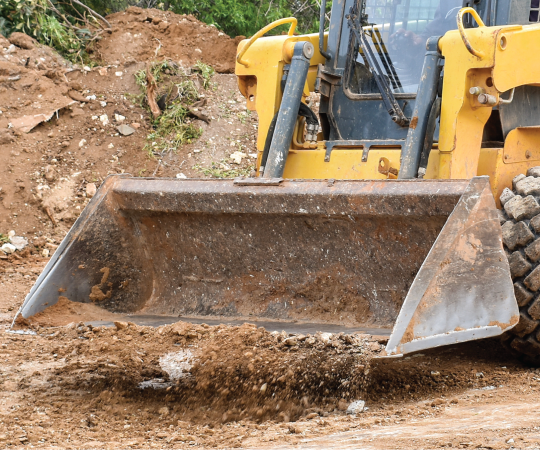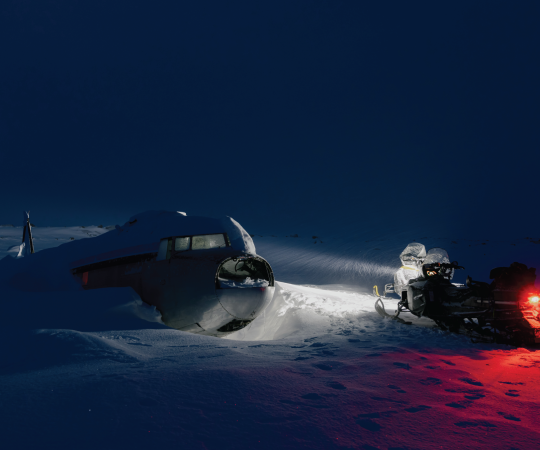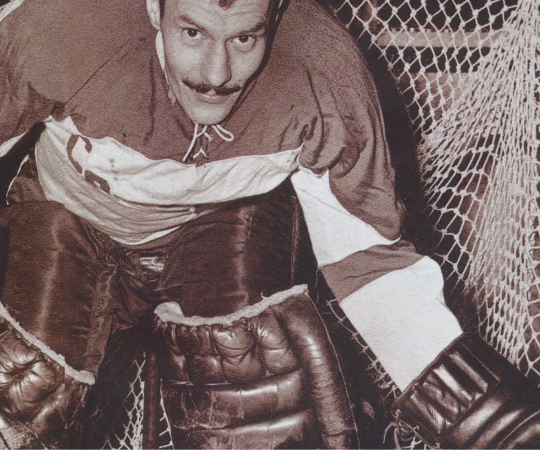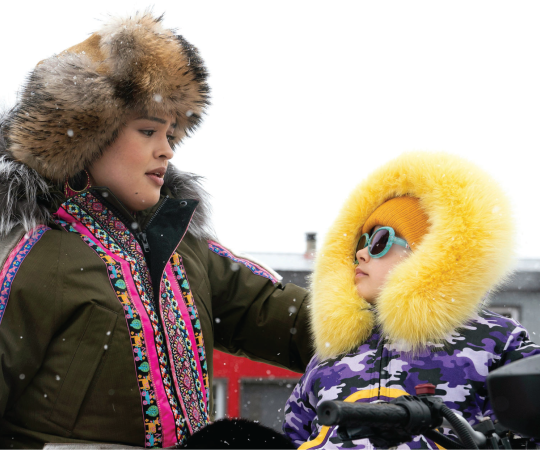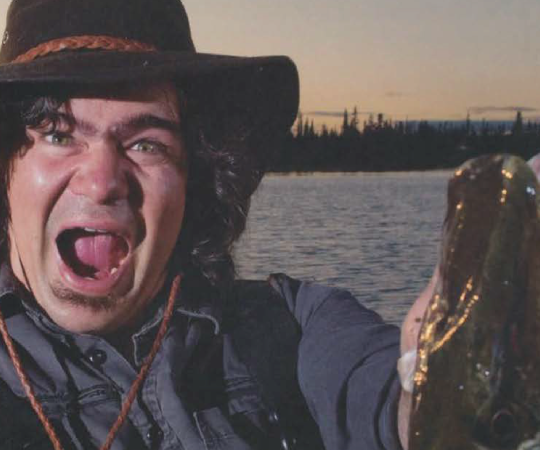Art Johns is hard to find. The 78-year-old Tlingit cowboy says he's deathly allergic to sitting around. The best time to catch him, he advises, is in the morning, before he leaves the house. Like, 7 am. Otherwise, you'll have to go looking for him. He might be snowmobiling up his trapline, or riding a packhorse into the mountains. Or teaching sixth-graders how to butcher a moose, or presiding over a high-stakes wildlife management meeting, or crooning for a crowd with his guitar. Or he might be up to any one of dozens of other activities. For Art, it has been a long, illustrious and very busy life.
So to meet him, I go early. I take a stretch of the Alcan that his father, Johnnie Johns, blazed for the U.S. Army back in ’42. At the little village of Tagish, I turn down Johns Road and pull into his homestead. The yard is full of scampering dogs, crumbling vehicles and unused horse trailers. A woman sits on a bench, gutting a pile of grouse. That's Art's girlfriend, Nola Lamken. There are three cabins on the property. The first is the sloping shack where Art grew up. The second is the home where his ex-wife, Elaine, still lives. I pick the third, where out front an old truck door is nailed to a tree. It's painted with the words "Johnnie Johns Outfitting." Then I go inside to meet one of the most revered men in the Yukon.
In a territory where the term Elder is the greatest honorific, Art Johns is, to me, the ultimate Elder. There are many reasons why: his gifts as a country-music performer, his uncompromising stance on wildlife conservation, his legacy as a big-game outfitter, and his role as the Yukon's best hunter, trapper, horse wrangler and trail guide. But most especially, Art is a courageous iconoclast. Like the lonesome cowboy that he is, he's unafraid to say what he thinks, and he backs up his words with action. Heads turn when he speaks.
This morning, Art is sipping black coffee beside the window of his cluttered kitchen. "I don't like putting things away," he explains. "I like to see where everything is." The tables and countertops are piled high; even the walls are covered with stuff: native artwork, braided sweetgrass, a guitar. A shelf beside the kitchen table sags beneath photo albums. He pulls one down. "Here's me when I started breaking horses," he says. "I was three years old. Dad just sat me on there and said, 'Away you go!'" And this, he says, is him hunting up the Dempster. "Boy, they had some fat caribou there. When they're fat, the ribs are good. We cook those up over a fire and eat them before we pack the meat out." Another shows Art and his then-teenaged son Tagish skinning a lynx on the set of an educational trapping video. One more and he's on a loaded horse embracing his youngest daughter, Rita, as a toddler. "She was always the last I'd say goodbye to and the first to see," he says of the decade he guided wilderness horse trips out of Spirit Lake Lodge.
Now Nola's in the kitchen, rinsing grouse meat under the tap, heating a wad of lard in a pan, fussing with rice and squash. Soon we're tearing into a KFC-bucket-sized pile of fried bird. Between greasy mouthfuls, Nola tells me how she met Art: over a bowl of wonton at the Caribou Hotel in Carcross. It was four years ago, when Art was in a serious funk. He'd just lost his son and split with his wife. "He was going through some rough times and looked kind of grey," she says. But when she invited him to come play music in Faro that weekend, his eye glimmered and he jumped in her van. It took two days to get to Faro, because Art insisted they stop and visit all his friends along the way. Now they're a couple and a music duo. With Nola on fiddle, they've played festival in Juneau, Dawson City, even Yellowknife. They're embraced wherever they go. "Everyone," she says, "loves Art."
And then, before I know it, they've grabbed instruments and launched into a kitchen concert. They play me cowboy classics by Hank Williams, Dan Seals and Kris Kristofferson: songs, Art says, that "are written from the heart." His guitar-picking is rhythmic and relaxed; his voice is sorrowful but steady. Cowboys and Indians—they're all the same to Art. "We're just a bunch of breeds," he says. "Call it what you want, my breed lives off the land." This year, Art and Nola were excluded from playing the native fiddle festival in Fairbanks, Alaska because Nola is white. "But that's where the music comes from," he says. "The traders and white men brought this music up with them and native people liked it and started playing it. Man, it bugs me!"
Art and I head off for a drive. We roll all the way to Johnson's Crossing and back, a three-hour slice of his life. Up there, he gestures, is the mountain where he got stranded overnight without blankets or food. And that hill over there is where he and his aunt smoked a porcupine out of its hole. We idle the car at what was once a huge Alcan construction camp, where Art and his mom would peddle her beaded moccasins to the soldiers. We pull up to a crater in the ground by Squanga Lake: It's where a Second World War fighter plane crashed and exploded only 100 metres from where he and his family were having a picnic. And see that spot way up in that clearing? That's where Art and his dad shot a "nice big moose." He says, "Once we loaded up the meat, Dad was gone. I had to run all the way down just to keep up."
Lots of Art's stories revolve around his dad. Like Art, Johnnie Johns was a Yukon legend. Burn during the madness of the gold rush, he was a big-game guide for dukes, doctors and presidents, and helped lead the bulldozer convoy down a big chunk of what would become the Alaska Highway. Gone since 1988, he left tracks all over the territory. His son, reverent of his father's reputation, has strived to fill his shoes. "Dad was hard on me," Art says. "He wanted me to be working all the time. I really appreciate that I grew up that way. It's why I always have to be doing something. Man, I can't just sit around."
For half a century, the Johns had a vast outfitting empire, with cabins in all the southern Yukon's best game corridors. Art remembers fondly their high-alpine Rose Lake camp, where he helped rich men hunt sheep and bears. During his downtime there, he says, he "played guitar for the horses." Once, in an emergency, he had to race back to Tagish. He rode his horse for 26 hours stopping only for tea and beans. "You can't go fast; you have to watch your horse," he tells me. "That's your animal. You have to look after him."
Indeed, animals are Art's greatest concern. His dad taught him how to hunt right: to study populations, to never over-harvest, to use the whole animal. But not everyone was taught like that, and in the southern Yukon, caribou and moose numbers have plummeted. In the early ’90s, Art saw the southern Lakes caribou, once tens-of-thousands-strong, dwindle to a few hundred animals. He went to war for the caribou, pushing the Yukon government and six First Nations to set up a hunting ban. Getting all those groups onside was a tall order, but it worked.
Despite such successes, Art remains a man on the fringe. As a kid, he lost Indian status, because back then, the only way his dad could be an outfitter was to give up his family's Tlingit rights. "That made it tough on me," Art says. "I got it back only 20 years ago, after a lot of fighting." Ironically, though, he's one of the only members of his generation who still speaks Tlingit. It's because, due to the outfitting work, he was spared from the assimilative experience of residential school—except for a few years when, he says, he was beaten terribly. (The experience hardened him. "I never cried since I was eight years old," he says.) He also firmly disagrees with property ownership and Indigenous land claims. "We used it and moved on. We never tried to own anything. Now they tie us down to one spot."
When we pull into his driveway it's past supper time. I thank Art for his time and he says, "You gotta spend more than a day with me to know who I am." He's right. But I'm not sure if I have the energy.


